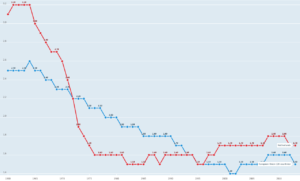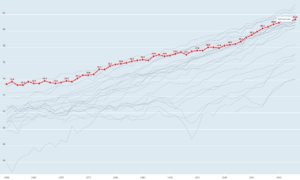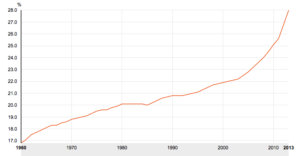Author: Talya Grecu
Yes, the Netherlands is ageing, like most countries around the world (Hoff 2014). Population ageing describes an increase in the number and proportion of older persons in a country’s population (Department of Economic and Social Affairs 2015). In the Netherlands, the elderly population — defined as individuals at or above the age of 65 — has increased dramatically from 7.7% of the total population in 1950 to 17.1% in 2013 (OECD 2018b). This reflects a similar trend across the European Union (EU), where the average elderly population has increased from 8.9% of the total population to 18.4% in 2013 (OECD 2018b). Moreover, the population of elderly in the Netherlands is expected to continue increasing. It is forecast that by 2040 the elderly population will make up over 25% of the total Dutch population (Hoff 2015).
Why does this happen?
The main causes of population ageing in the Netherlands are declining fertility rates and increasing life expectancy (Carey 2018). These demographic trends restructure the age composition of a population by shifting the relative weight from younger to older groups — in simple terms, meaning that there are more older people than younger people.
In the Netherlands fertility rates have almost halved, from 3.70 children per woman in 1960 to 1.70 children per women in 2013 (OECD 2014). Once again, this mirrors trends in the rest of the EU, where fertility rates have declined from 2.50 children per woman in 1960 to 1.50 children per women in 2013 (OECD 2014).
 Figure 1. Fertility Rates in the European Union (blue) and the Netherlands (red), 1960-2013 (OECD 2018)
Figure 1. Fertility Rates in the European Union (blue) and the Netherlands (red), 1960-2013 (OECD 2018)
These decreasing fertility rates have been accompanied by increasing life expectancy. The life expectancy at birth in the Netherlands has increased from 73.5 years in 1960 to 81.4 years in 2013 (OECD 2018a). The EU as a whole has achieved similar levels.
 Figure 2. Life expectancy at birth (years) in the EU with Netherlands highlighted (Red), 1960-2013 (OECD 2018a)
Figure 2. Life expectancy at birth (years) in the EU with Netherlands highlighted (Red), 1960-2013 (OECD 2018a)
What are the consequences of an ageing population?
Population ageing in the Netherlands and the rest of the world has profound economic, political, and social consequences. When the proportions of different age groups change, their relative importance in society also changes. This leads to economic, political and social pressures for changes in resource distribution (Department of Economic and Social Affairs 2015).
 Figure 3. Grey pressure in the Netherlands (people 65+, expressed as percentage of the number of people 25-65), 1960-2013 (CBS 2018)
Figure 3. Grey pressure in the Netherlands (people 65+, expressed as percentage of the number of people 25-65), 1960-2013 (CBS 2018)
One major consequence of population aging is a substantial increase in the pressure exerted on pension schemes, the healthcare system, and other social services (Kune 2009). Population aging means that while the elderly make up an ever-increasing proportion of the population, the proportion of children is decreasing. This puts pressure on the Dutch pension system because (1) more people are drawing on pensions and (2) there are less people in the workforce to pay for them. This is captured by the steady increase in the old age dependency ratio or ‘grey pressure,’ which is the ratio between people over 65 years and people between 20 and 65 years old (OECD 2014). This ratio increased from 16.8% in 1960 to 28.0% in 2013 and is expected to further increase to 52.5% in 2050 (OECD 2014).
In addition to placing pressure on formal service provision, population ageing also impacts more informal aspects of society. For example, fertility declines associated with population ageing mean that elderly have fewer young family members to whom they can turn to for support (Department of Economic and Social Affairs 2015). This brings into question the long-term sustainability of intergenerational social support systems necessary for the wellbeing of young and elderly alike.
Moreover, this demographic trend underscores the importance of issues affecting the Dutch elderly population, such as vulnerability in relation to income poverty, food security, social isolation, and health. As the Dutch elderly population continues to grow, so will the importance of these issues.
References
CBS (2018). “Population; key figures.” Statline. At https://opendata.cbs.nl/statline/#/CBS/en/dataset/37296eng/line?ts=1539439711059.
David Carey (2002). “Ageing populations: How the Dutch Cope,” OECD Observer. At http://oecdobserver.org/news/archivestory.php/aid/741/Ageing_populations:_How_the_Dutch_cope.html.
Department of Economic and Social Affairs Population Division (2015). “World Population Ageing 1950-2050.” United Nations, 1.
OECD (2014). “Ageing and Employment Policies: Netherlands 2014: Working Better with Age.” OECD Publishing. At http://dx.doi.org/10.1787/9789264208155-en
OECD (2018a). “Life Expectancy at Birth.” OECD Data. At https://data.oecd.org/healthstat/life-expectancy-at-birth.htm#indicator-chart.
OECD (2018b). “Fertility Rates.” OECD Data. At https://data.oecd.org/pop/fertility-rates.htm.
Stella Hoff (2015). “Pensions: Solidarity and Choice.” The Netherlands Institute for Social Research, 23.
Jan B. Kuné (2009). “Population ageing and the affluent society: The case of the Netherlands.” Pensions: An International Journal 14(4): 231.